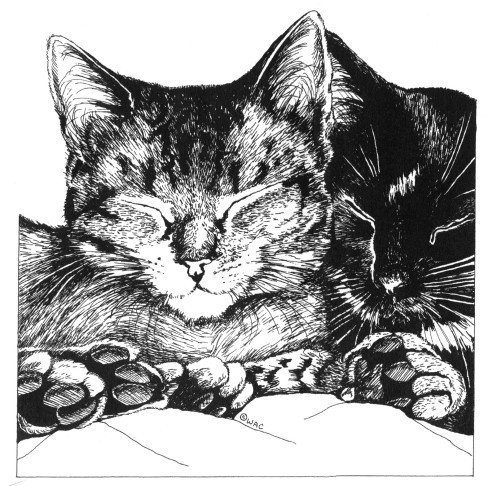Feline Friday: Cat Snuggling 101

Snuggling works! Copr. Wendy Christensen
Today once again I share blog-space with an awesome cat writer, artist and behavior purr-son (I wear her jewelry…just sayin'…). Please help me welcome my colleague Wendy Christensen, who manages her clowder with a velvet paw as they provide furry inspiration. There's a reason they call her the "Cat Herder" and those who love cats will recognize their own cats' foibles in Wendy's experience. The more cats you have, the greater the chance for (ahem) cat-astrophes. How many cats do you have? How do YOU do it? Take a lesson from Wendy and please share your experiences in the comments. Take it away, Wendy!
*********************
"Cats do what they do because it works." This insight, offered by ethologist and author Myrna Milani, DVM, has long guided my approach to cat-keeping.
Just like us, cats have problems to solve. The solutions they choose make perfect sense to them. They just don't always make sense to us. A cat chooses a behavior because it solves a problem for her in the most satisfying and acceptable way she can devise at that moment. Her solution is not always what you would choose. If you don't like her solution, it's up to you to devise a superior – from the cat's point of view – alternative. And that's the essence of the cat-keeper's job: figuring out what works, and what doesn't, for both cats and humans.
When it comes to cats, one should never say "never" (especially if the cats are calicos), but there are a few things that never work (yelling, hitting, force, punishment) and a few things that, intelligently deployed, can work wonders (praise, petting, play, pampering, diversion, persuasion).
My life with cats is a work in progress. I don't just live with my cats, I study them. I'm no animal communicator (I wish I were), but I try to get into their furry little heads and figure out what they're thinking, what they want, and what's important to them.
What I've discovered is that what cats want is: plenty of everything, plus extras. Extra litter boxes. Extra treats. Extra cat trees. Extra toys. Extra attention. They constantly crave reassurance that the resources they care about will remain plentiful and accessible. They're extraordinarily good at sharing, but hate being forced to share. They're quite savvy about managing resources among themselves, as long as they possess a general sense of abundance and continuity. What I've learned is that the cat-keeper's job is to be a good provider.
Their lack of opposable thumbs means cats can't tinker with their environments to the extent that we can. But the cat is a practical animal with an engineer's curiosity about the world, and cats can make more sophisticated problem-solving decisions than we sometimes give them credit for. They try something. If it works, they keep doing it. If it doesn't, they tinker with the solution and try again.
Like my cats, I have a practical engineer's curiosity about what works and what doesn't. Whether I'm building a piece of cat jewelry, painting a cat portrait, or offering cat behavior advice to puzzled cat owners I focus on efficacy and efficiency: finding the simplest, most elegant solution that works. Over time, my collection of favorite products, tools, tips, tricks and techniques grows.
In managing our shared environment, I'm perpetually searching for what's going to work best for the cats and for me. I identify problems, tinker with this and that, consider possible solutions. Sometimes, the cats beat me to it.
Several of my cats have always been rather prickly about snuggling up "too close" to other cats. They had to maintain a certain perimeter of dignified separation. Despite my efforts to encourage sharing, my bed's cat-carrying capacity remained stubbornly at about three. Then came the ice storm of 2008 – no heat or power for five days. It started out cold, and got colder. I put out multiple blankets and kitty beds so the cats could bundle up in (relative) coziness. But they didn't retreat to their kitty beds. They piled up on top of me. All ten of them.
This necessitated a rapid and wholesale breakdown of the "dignified perimeter" theory. Ever since, mass snuggling has been the norm. It turns out that sharing works. So, though cats generally hate changes, they're not afraid to change their minds when they discover something that works.
Time to share, now that we know it works. Here are some of the things that work for me and my cats:
Interior screen doors
ZeroOdor
Hard floors with sealed edges
Da Bird
Washable everything
Febreeze Laundry Odor Eliminator
Extra-large litter boxes, on wheels
The Drinkwell-360 cat fountain
Cat trees in every room
DeLonghi steam cleaner
Fleece throws in every color (cats love fleece!)
Hills t/d (as treats)
Dr. Elsey's Precious Cat litter
OK, your turn. What works for you and your cats?
***********************
I love hearing from you, so please share comments and questions. Do you have an ASK AMY question you'd like answered? Stay up to date on all the latest just subscribe the blog, "like" me on Facebook, listen to the weekly radio show, check out weekly FREE PUPPY CARE newsletter, and sign up for Pet Peeves newsletter with pet book give-aways!
Filed under: Cat Behavior & Care Tagged: Amy Shojai, cat art, cat behavior, cat books, cat jewelry, cats, Wendy Christensen











